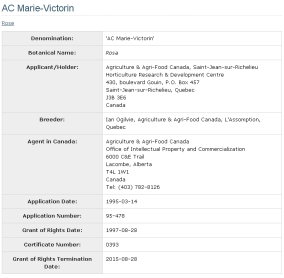Patent protection
The breeder for a new cultivar (cultivated variety) or hybrid of rose may obtain a patent protection. The new plant must meet four criteria to be granted a patent.
The first is novelty, which means that the same rose, whether a hybrid or a variety, must not already be named or sold.
Secondly, the new rose variety must have involved the technical intervention of a human being. This means one can't patent a new rose variety that occurred by chance or by environmental factors alone. Human intervention must have been applied in the development of the new rose variety. For example, the rose must be the result of a controlled breeding or selective propagation program.
Thirdly, the new rose variety must display an inventive step compared to what is already available. It must be clear which steps have lead to the improvement or specific caracteristics.
Finally, the patent application must describe the new variety in enough detail for a rose breeder or suitably skilled person to recognise and reproduce the new rose variety.*
 Plant Breeder's Rights
Plant Breeder's Rights
Apart from patents, intellectual property for new rose varieties can be protected through Plant Breeder's Rights (PBR), which is essentially a form of patent. Unlike standard patents, which apply to inventions in most scientific and engineering disciplines, PBR is specifically for new plant varieties. It gives the breeder exclusive rights to a range of commercial activities for the particular rose variety.* In Canada, the
Canadian Food Inspection Agency administers the
Plant Breeders' Rights Act (1990) and
Regulations which provide legal protection to plant breeders for new plant varieties for up to 18 years.
Authorities
In Canada, hybrids may be managed by the
Canadian Ornamental Plant Foundation (COPF), a non-profit organization that helps to fund new ornamental plant development and that has been providing royalty administration since 1964.
The
American Rose Society serves as the
International Cultivar Registration Authority for Roses and follows the rules set forth by the
International Code of Nomenclature for Cultivated Plants in the registration of new rose varieties.
About names
To be acceptable names, the epithets given to new hybrids or cultivars are enclosed in single quotation marks and have to be unique to the genus in which the new plant has been developed. For example, the real name of Marie-Victorin rose from the Explorer series is
Rosa 'AC Marie -Victorin',
Rosa being the scientific genus and 'AC Marie- Victorin', the epithet designating the hybrid.
Parental lineage that goes back more than a century of hybridization
On the other hand,
Rosa 'AC Marie -Victorin' is the result of a hybridization between two floribunda roses, 'Arthur Bell' and 'John Davis', themselves hybrids between polyantha roses and tea roses. The polyantha roses are also hybrid roses created in the late 1870s from crosses made by the rose grower Jean -Baptiste Guillot, between two species:
Rosa multiflora and
Rosa chinensis. As for the tea roses, their lineage is even more complex because it comes from multiple hybridization. This means that the hybridization of roses must take into account the particularities of these parental lines to obtain a rose with the desired qualities.
*Part of this text has been adapted or reproduced from abc.net.au


